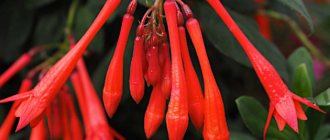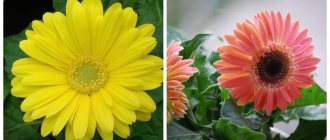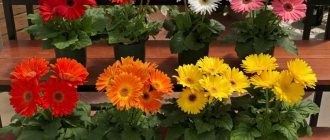Fuchsia (Fuchsia) is a genus of perennial plants from the fireweed family, consisting of approximately 100 species. The culture is mostly hybrids. Valued for its lush, abundant, long-lasting flowering. Attracts attention with bright, often contrasting, bent sepals and petals collected in a tubular corolla. Apart from the dormant period, caring for fuchsia is not too difficult for experienced gardeners. Beginners should remember that the plant is capricious, requires attention, and reacts quickly to any mistake.
What to do with a flower after purchase
It is unknown in what conditions the fuchsia was kept; it needs not only quarantine, but also a period of adaptation to the new place. The pot is placed separately from the main collection on a northern windowsill or in partial shade if it is hot, often sprayed, and watered carefully.
The main thing you need to keep an eye on is whether you brought a whitefly from the store. But a delicate plant may also have fungal diseases, which will certainly manifest themselves within 2 weeks as dark spots on the leaves.
After adaptation, they look to see if the fuchsia needs to be transplanted into another pot. If the earthen ball is completely entwined with roots, it is transferred to a slightly larger container, even if it is in bloom. The soil cannot be replaced at this time, except in extreme cases when it comes to saving the plant. Then all the buds are removed.
Landing
Decorative crops should not be planted in a pot that is too large. First you need to select a small container, the diameter of which does not exceed 9 cm. Gradually, the roots will entwine the space provided to them, and then they can be planted in a larger pot.
Before planting, it is necessary to prepare a medium for growing fuchsia. Flowers need fertile soil. Expanded clay or any other drainage material is placed at the bottom of the pot. Soil is poured on top of it. A plant is planted in it. The pot must be filled with soil so that there are no voids between the roots and the walls of the container. To prevent their appearance, you need to lightly shake the pot and gently knock on it. Under no circumstances should you compact the earth with your hands! Pores must remain in the soil.
Home care
No matter what they write in reference books or on the Internet, fuchsia requires increased attention from its owners. But beginning gardeners can also grow it if they choose a simpler variety. The main thing is that caring for fuchsia should be regular, and it is necessary to study the characteristics of the plant before purchasing, and not when problems begin.
Temperature and lighting
The culture can withstand partial shade, although it blooms worse there. Ideally, fuchsia needs bright, soft light, but direct rays are only permissible in the morning or evening. The southern window sill is not suitable for the plant during the active growing season; it is better to place the pot on the western, eastern, or, in extreme cases, northern.
If fuchsia spends the rest period (wintering) in a living room, choose a bright place for it.
The plant is afraid of overheating, but feels good in the cool:
- outdoors in summer;
- in winter at home it can stand on a glassed-in balcony.
Regarding the acceptable temperature, the opinions of Dutch gardeners and domestic flower growers differ:
- The first claim that during the dormant period, growing fuchsia should take place at 6-10° C; in summer, no more than 20° C is permissible.
- Our compatriots indicate a range from 2-6° C to 24° C, respectively.
Both are right. It all depends on whether we are talking about a greenhouse plant purchased in a store, or a fuchsia propagated by cuttings and adapted to a specific content.
Growing and caring for them at home in summer will not be so difficult if you install a humidifier and keep the air conditioner on. You can place a pot of fuchsia in a large pot, fill the gap with expanded clay, sphagnum or soil - this will protect the root from overheating.
Shady areas are usually cooler. But if the plant lacks light, fewer buds are formed, the internodes are stretched out, and the bush becomes loose and lethargic. The owners will have to find the right balance on their own - so that the temperature is as low as possible, but there is enough sun. Otherwise, they will see the bush in full bloom only in the fall.
Watering and air humidity
Caring for fuchsia at home requires very careful irrigation. A delicate plant can die from stagnation of water in a few hours; it’s good if the owners manage to take cuttings.
The literature recommends that in spring or summer the soil should always remain slightly moist. Just in case, practicing gardeners dry the surface of the earthen ball a little, but by a few millimeters, and not 2-3 cm, as for other plants.
Use warm, settled water. Excess liquid from the pan must be removed after 30-40 minutes.
During the dormant period, the fuchsia watering regime changes. If the plant overwinters on a windowsill, the earthen ball is moistened regularly, but much less often than in spring or summer.
The approximate frequency of watering during warm wintering is once a week. But you need to focus on your own conditions:
- has the fuchsia shed its leaves for the winter;
- room temperature;
- dry or humid air in the room;
- whether there are buds on the bush or not.
When fuchsia is taken out onto a glazed balcony, into a frost-free basement or cellar, the substrate is watered extremely rarely, just so that the lump does not dry out completely.
Air humidity during the growing season needs to be high. In summer, the plant is sprayed twice a day - early in the morning and when the sun begins to set. If you do this in the middle of the day, the water droplets will turn into lenses and unsightly burns will appear on the leaves and flowers. At night, the temperature can drop significantly, especially in the off-season, then the delicate fuchsia that remains wet after sunset can rot.
After flowering and until mid-November, spraying is done in the first half of the day, periodically. In winter they are stopped.
Feeding schedule
Fuchsia grown as a houseplant is fertilized only with store-bought preparations. Authoritative sources advise alternating the mineral complex with organic matter, but we are not talking about mullein infusion, bird droppings or other homemade remedies.
For abundant flowering or growth, fuchsia needs to be fed every 1-2 weeks, depending on the preparation, in moist soil. Be sure to follow the instructions:
- if there is a deficiency of nutrients, buds will not appear on the plant;
- due to the excess, rapid development of green mass will begin, existing flowers will quickly fade or fall off, new ones will not emerge.
In winter, the crop is not fertilized, otherwise the plant may die.
Trimming and pinching
Fuchsia buds form at the ends of the shoots - the more side branches, the more abundantly it will bloom. Ampelous species and varieties will never cascade without formation; bush varieties grow one-sided, liquid, elongated.
Before the cutting blooms for the first time, it is pinched:
- I time - over the second pair of leaves;
- II – when the lateral branches grow, just above the 2-3rd internode;
- III - the same for tall bush varieties.
You can shape fuchsia with your fingernails, nail scissors, or tweezers with curved tips.
The grown cut shoots are used for propagation. To make the plant produce buds faster, pinch the top pair of leaves from a very small cutting.
Pruning fuchsia at home must be carried out before the dormant period. The operation is performed after flowering, at the end of October or November. If buds continue to form, you need to wait longer. Shoots are shortened by no more than a third.
The main pruning of an adult plant is carried out in the spring:
- the crown is lightened - shoots directed inwards are removed;
- of the intersecting branches, the strongest is left;
- the stems of the ampels are shortened by a third;
- pinch all the shoots on the bushes.
Indoor fuchsia can be formed like a standard tree. This takes approximately 3 years:
- Select a strong branch on the plant.
- Tie it to a vertical support at each internode.
- Gradually cut out the lower shoots and remove the leaves on the stem.
- The tops on the stem are plucked out as soon as they appear.
- A crown of 3-7 skeletal branches is formed at the top.
- To make fuchsia lush, pinch out the side shoots, leaving 2-3 internodes on each.
Popular varieties of ampelous fuchsia
Ampelous fuchsia is a perennial evergreen plant from the fireweed family. Under natural conditions, it is found in New Zealand, South and Central America.
Fuchsia has three growth forms - bush, semi-ampelic and ampelous. The latter is especially loved by gardeners - thanks to its flowing curly branches and spreading cascading crown, it is perfect for growing in hanging pots, decorating balconies, terraces, and gazebos.
There are more than 2000 varieties of fuchsia, differing in the size of the bush, the colors of the foliage and inflorescences. The most popular include:
- Fuchsia archie owen - this variety, originally from America, is distinguished by terry, lush buds with jagged tips of gradient petals. The color of the petals is light pink, the sepals are most often dark pink.
- Fuchsia Lenny Erwin is a plant with snow-white sepals and a purple “skirt”. The buds are large, terry type. Bushes of this variety grow up to 30-40 cm.
- Fuchsia peachy is a variety with large and beautiful double white flowers with a soft pink coating, as well as a pink “skirt” with peach splashes.
- Fuchsia Bella Rosella - this variety is distinguished by its extremely large flower buds, which can reach 12-13 cm in diameter. The flowers are double, bright lilac or pink with snow-white stamens.
- Fuchsia bicentennial is one of the rarest varieties of ampelous fuchsia. The inflorescences attract attention with their bright orange color, large and slightly oblong double buds. This plant is demanding on temperature conditions, so it needs careful care.
Despite its exotic and spectacular appearance, ampelous fuchsia is undemanding in care. This unpretentious plant is perfect for novice gardeners, as well as those who do not have a lot of time to care for indoor flowers.
Features of seasonal care
When growing fuchsia at home, the maintenance depends on the time of year. From spring until the end of flowering, care is usual; in the fall, adult specimens with lignified shoots begin to fall. If cool conditions are not provided in winter, the plant may die, or become very elongated and weakened, and will only be suitable for propagating fuchsia by cuttings in the spring.
Care during the flowering period
It is easier to grow a crop on the street or balcony; the bush will be much more beautiful there than in a stuffy room. Fuchsia develops faster in the fresh air, holds buds longer and puts out buds more readily.
During the active growing season, the plant:
- water regularly, not allowing the soil to dry out;
- to prolong flowering, remove faded buds;
- spray frequently, in hot weather - twice a day, morning and evening;
- feed at least once every 2 weeks;
- Every year the plant is replanted and pruned in the spring;
- young shoots are pinched all season long;
- kept in a bright room, protected from direct rays at midday;
- in summer the temperature is not allowed to rise above 24° C.
During flowering, fuchsia is protected from drafts. It is not recommended to move the pot, turn it, or pick it up, otherwise the plant will drop its buds.
Care during the rest period
Even experienced gardeners can die from fuchsia in the winter. In order for the bush to survive an unfavorable period more easily, it needs to be prepared. After flowering:
- no longer fed;
- stop spraying;
- gradually reduce, and by the end of November, reduce watering to a minimum;
- do light pruning;
- for preventive purposes they are treated against pests.
If the plant produces buds when it is supposed to rest, they are cut off so as not to deplete the bush.
Young specimens should overwinter on a bright, cool windowsill or insulated balcony. The recommended temperature is not higher than 12° C, preferably 6-10° C.
Fuchsias with mature, lignified branches can stand in a frost-free cellar or basement without light, but their leaves should be torn off. There the temperature should be about 2° C, not fall below 0° C. Just in case, the pots can be placed in boxes with sawdust.
How to properly transplant an adult plant
Fuchsia is moved to a new pot every year. This is done at the beginning of the growing season, immediately after spring pruning. If necessary, you can even transfer a flowering bush into a large bowl, the main thing is not to destroy the earthen lump.
Priming
Fuchsia requires slightly acidic soil, loose and permeable. It is important that it maintains its structure well throughout the year and does not become compacted - even a single stagnation of water in a pot will most likely lead to the death of the plant in a few hours. Mixtures intended for geraniums or Usambara violets are suitable from store-bought substrates.
You can prepare the soil yourself from pre-disinfected components taken in equal proportions:
- turf land;
- rotted litter of deciduous trees;
- humus;
- high peat;
- sand.
Pieces of charcoal will not interfere with the mixture. The minimum volume of substrate for 1 adult bush is 1 liter.
Pot
You cannot grow fuchsia beautiful and healthy in the wrong container. If the pot is too large, the plant:
- stops developing;
- refuses to branch;
- sick;
- withers;
- some of the leaves turn yellow, dry out, fall off;
- does not bloom;
- the buds fall off.
The diameter of the new container is needed 2-3 cm larger than the previous one. At least 20% of the volume should be drainage. If the owners have chosen a beautiful designer high pot for planting the ampel, the “excess” space is also covered with expanded clay.
It is recommended to plant not 1, but several cuttings in bowls. Otherwise, the soil on the sides will not be absorbed by the roots, which will lead to acidification of the substrate, plus it will delay flowering for several weeks.
The best material is plastic. Clay breathes well and protects the root from overheating, but ceramic pots often only have one small drainage hole, which is unacceptable for fuchsia. You can place the plant in a regular shipping container and then decorate it with a flower pot.
Fuchsia transplant
Despite its capricious nature, you can move a flowering plant into a new pot. Time limits:
- dormant period – growth processes slow down, restoration of the root system takes a long time;
- heat - fuchsia is very sensitive to overheating, if you add stress from replanting, it can die.
In spring, the crop quickly recovers and reproduces well. You don't have to throw away the cut branches.
Transplant process:
- Pour drainage and some fresh substrate into the new pot.
- Remove the fuchsia from the old container.
- Inspect the earthen lump. Trim the root if necessary.
- Place the plant at its original height in the center of the new container.
- Fill the empty space with substrate.
- Compact, water.
It is necessary to cover the bush with glass or film only when the earthen clod is destroyed. The transplanted plant is placed in partial shade for several days.
Why doesn't it bloom?
Flowering is usually profuse with proper care. There are a number of factors influencing the lack of flowering of fuchsia :
- not enough light;
- temperature too high;
- incorrect amount of fertilizer;
- pruning done late;
- poor conditions for wintering the plant;
- a pot of inappropriate volume (until the root system covers the entire pot, the fuchsia will not bloom).
We recommend looking at why fuchsia does not bloom:
Methods of propagation and rooting
Vegetative propagation of fuchsia should not be difficult even for beginners. Hybrids can be propagated with seeds only if they are obtained from reliable producers; those collected with one’s own hands will produce flowers that do not inherit varietal characteristics.
Leaves
Sometimes on the Internet there is a statement: it is possible to grow fuchsia from a leaf, which is not true. And the authors themselves indicate: along with the plate, you should take a bud and a piece of stem. This is already propagation by cuttings with one node, and not a leaf.
Seeds
Planting material must be purchased at the store. You can propagate species plants yourself this way. But pollination on indoor fuchsias will have to be done manually - with a cotton swab or a soft brush.
First, the seeds are pickled in a slightly pink solution of potassium permanganate, then sown in a peat-sand mixture. Cover with glass and keep at 20-25°C and high humidity. Seedlings dive in the phase of 2 true leaves.
The method is unreliable - it depends on the quality of the seeds, subsequent care, and propagation often ends in failure.
Cuttings
The tops of shoots of 5-8 cm with at least 2 internodes take root best. Longer ones may have their growing point dry out, short ones rot easily.
The cuttings remaining after trimming the fuchsia are freed from the lower leaves; if the upper ones are too large, the plates are shortened by half. One node should be in water or wet sand, the second should rise above their surface. The planting material is covered with glass or transparent film.
With high humidity, diffuse light and a temperature of about 20 ° C in early spring, rooting will take about two weeks.
Fuchsia can be propagated in the summer, but in the heat, growth processes are suspended. The cutting may rot.
Planting fuchsia
When the apical shoot takes root 1-2 cm long, it needs to be planted in a plastic cup filled with soil with a hole at the bottom. The substrate should be light so that the roots grow well in search of food.
Make a hole in the soil of a size large enough to insert the cutting without disturbing the lower shoots, sprinkle it, press it down and water it. During the season, at least 2-3 transplants into a large container will be required.
Ampels are sometimes immediately planted with several cuttings of different varieties in a common flat pot.
Fuchsia is moved to a bright place, but protected from direct sun. If the cuttings were previously under film, young plants are gradually accustomed to fresh air.
Diseases and pests
Rarely does anyone succeed in caring for fuchsia at home without encountering whiteflies. Beginning gardeners, or those who are not ready to constantly fight an annoying insect, often give up and get rid of the plant.
It is much easier to control whiteflies in open ground than at home, in a greenhouse or winter garden.
Other pests that may appear on fuchsia include:
- spider mite;
- aphid;
- thrips;
- nematode;
- mealybug.
Before the dormant period, fuchsias must undergo preventive treatment against pests.
The plant is sick:
- fusarium;
- various spots;
- root and stem rot;
- rust.
The culture does not respond well to treatment, since all the vegetative organs of the plant are very delicate, the flower disappears quickly. Pests are controlled with insecticides, and diseases are eliminated by spraying the bush with fungicides.
How to care for fuchsia during flowering
An important rule when caring for fuchsia during flowering is not to turn it in different directions towards the light and not to move it to other places. Because of this, it will only drop flowers.
The plant should not be sprayed during flowering. Drops of water will fall on the sensitive petals, and then they will begin to deteriorate and fall off. In general, the flowering of plants, including fuchsias, is a period during which they should be disturbed as little as possible; It’s better, on the contrary, to leave him alone, admiring the flowers from afar. For humans, flowering is simply a beautiful sight, for pollinating insects it is a source of food, and for the plant itself it is, in a certain sense, stressful. The plant spends a lot of energy on the formation and blooming of flowers, and before flowering it undergoes preparation, sometimes lengthy. For a plant, the ultimate goal of flowering is the formation of seeds and procreation.
Problems during cultivation
The larger the fuchsia flowers, the more capricious the plant. Beginning flower growers are not recommended to choose the most beautiful variety in the catalog; it is better to start with something simpler. Then there will be less disappointment in culture.
When growing fuchsia, owners often encounter problems:
- many lower leaves wither and fall off at once - drying out of the substrate;
- buds fall off, plates fly around regardless of location on the bush - heat;
- shoots stretch out, no flowering - insufficient lighting;
- fuchsia buds do not last long - the winter is too warm or there is a lack of nutrients;
- the plates wither and the soil is wet - overflow;
- the plant suddenly drops its flowers - perhaps the pot was rearranged or moved.











